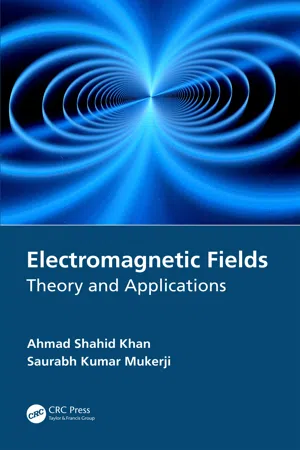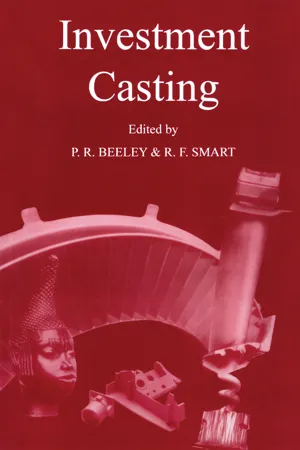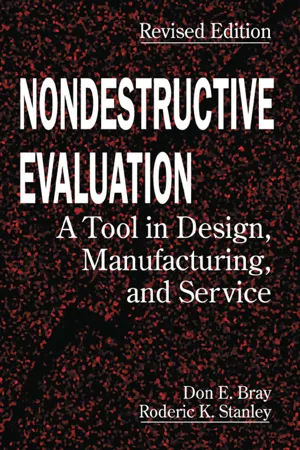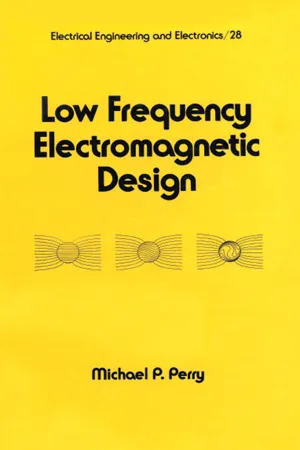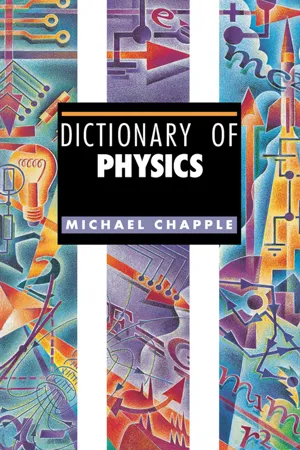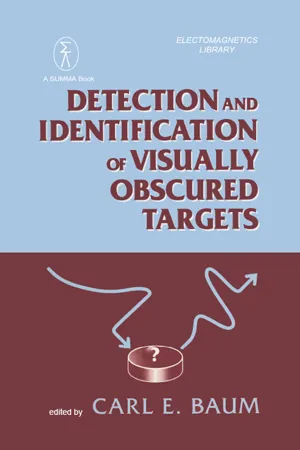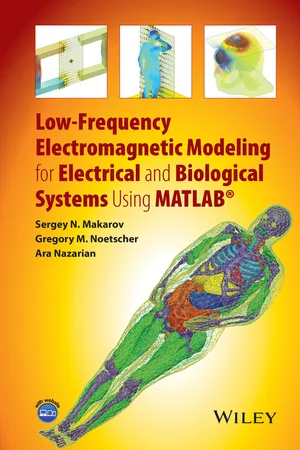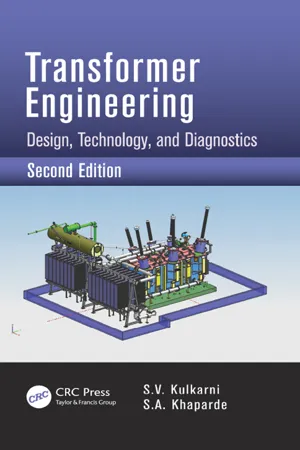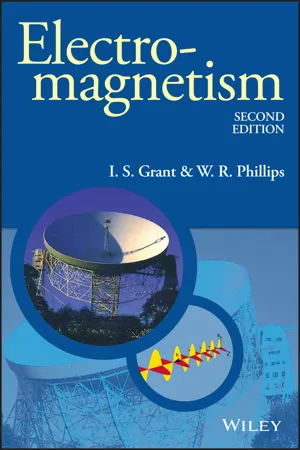Physics
Eddy Current
Eddy currents are circular electric currents induced in conductive materials when exposed to a changing magnetic field. These currents create their own magnetic fields, which oppose the original magnetic field that induced them. Eddy currents are responsible for energy loss and heating in electrical devices, but they are also utilized in technologies such as eddy current testing for non-destructive material inspection.
Written by Perlego with AI-assistance
Related key terms
Related key terms
1 of 4
Related key terms
1 of 3
10 Key excerpts on "Eddy Current"
- eBook - ePub
Electromagnetic Fields
Theory and Applications
- Ahmad Shahid Khan, Saurabh Kumar Mukerji(Authors)
- 2020(Publication Date)
- CRC Press(Publisher)
21 Eddy Currents21.1 Introduction
The terms current, current density, and their types were introduced in Chapter 8 . The displacement current and displacement current density were described at length in Chapter 15 . Yet another type of current, referred to as an Eddy Current, is the subject of the present chapter. This chapter describes the genesis, meaning, importance, and the applications of Eddy Currents. The Eddy Current equation and its solution in one, two, and three dimensions also is discussed. Finally, Eddy Currents in anisotropic medium are described.21.2 Basic Aspects
Eddy Currents are circular electric currents induced within conductors by a changing magnetic field in the conductor, in accordance with Faraday’s law of induction . These are also referred to as Foucault currents . These flow in closed loops within conductors, in planes perpendicular to the magnetic field. They can be induced within nearby stationary conductors by a time-varying magnetic field created by an electromagnet or transformer, for example, by relative motion between a magnet and a nearby conductor. The magnitude of the current in a given loop is proportional to the strength of the magnetic field, the area of the loop, and the rate of change of flux, and inversely proportional to the resistivity of the material.By Lenz’s law , an Eddy Current creates a magnetic field that opposes the magnetic field that created it, and thus Eddy Currents react back on the source of the magnetic field. For example, a nearby conductive surface will exert a drag force on a moving magnet that opposes its motion, due to Eddy Currents induced in the surface by the moving magnetic field. This effect is employed in Eddy Current brakes , which are used to stop rotating power tools quickly when they are turned off. The current flowing through the resistance of the conductor also dissipates energy as heat in the material. Thus, Eddy Currents are a source of energy loss in alternating current (ac) inductors , transformers , electric motors , and generators , and other ac machinery, requiring special construction such as laminated magnetic cores to minimize them. Eddy Currents are also used to heat objects in induction heating furnaces and equipment , and to detect cracks and flaws in metal parts using Eddy Current testing instruments - eBook - ePub
- Philip R. Beeley, Robert F. Smart(Authors)
- 2023(Publication Date)
- CRC Press(Publisher)
b . Typical currents of this sort resemble the eddies in flowing streams of turbulent water; hence the name. The amount of electrical current flowing in these eddies is determined by the electrical conductivity and permeability of the test object as well as by the frequency and amplitude of the applied electromagnetic field. The Eddy Currents create in turn their own electromagnetic field, which may be sensed either through its effects upon the primary excitation coil, or by means of an independent sensor.Fig 20Production of Eddy Currents.Eddy Current methods of inspection are effective with both ferromagnetic and non-ferro-magnetic metals. They are not quite as sensitive to small, open defects as are liquid penetrant or magnetic particle methods. Because of the skin effect, Eddy Current inspection is generally restricted to depths less than 6 mm. The results of inspecting ferromagnetic materials can be obscured by changes in the magnetic permeability of the test piece. If electrical conductivity or other properties, including metallurgical properties, are being determined, changes in temperature must be avoided to prevent erroneous results.Applications of Eddy Current and electromagnetic methods of inspection to castings can be divided into the following categories:- Detecting near-surface flaws such as cracks, voids, inclusions, blowholes and pinholes.
- Sorting according to alloy, temper, electrical conductivity, hardness and other metallurgical factors.
- Gauging according to size, shape, plating thickness or insulation thickness.
Test equipment
In Eddy Current testing more than in any other method of non-destructive testing, the test system is designed to fulfil a particular need. The testing parameters which dictate the choice of one system over another are just as important as the test system itself. - eBook - ePub
Nondestructive Evaluation
A Tool in Design, Manufacturing and Service
- Don E. Bray, Roderick K. Stanley(Authors)
- 2018(Publication Date)
- CRC Press(Publisher)
Part V Eddy Current Techniques in Nondestructive EvaluationPassage contains an image CHAPTER 23 FUNDAMENTAL Eddy Current CONCEPTS 23-1. INTRODUCTION
In Eddy Current (EC) testing, a fundamental requirement is that the examined material has induced in it a distribution of currents. This restricts the technique to those materials that are electrically conductive. The currents within the inspected materials are formed in response to a changing electromagnetic field that is generated by a changing current in a conductor that is placed in close proximity to the material. They are constrained to the flow in closed loops within the inspected material, and themselves generate magnetic fields. These fields, in combination with the fields that excite the currents, must be detected either by electromagnetic induction in a coil, or a system of coils, or by sensors such as the halt element. In many cases the same coil is used both to excite the circulatory (eddy) currents, and also to detect their fields.The parameters that are important in EC testing can be divided into two categories: electromagnetic and physical. The electromagnetic properties that are of importance are:1. The source frequency, or frequencies (f1 , f2 …). These are also the Eddy Current and magnetic field frequencies.2. The electrical conductivity (σ) of the inspected part, and changes therein (Δσ). 3. The relevant magnetic permeability (μ) and changes therein (Δμ).These quantities affect the depth to which Eddy Currents penetrate into the inspected material. Knowledge of parameters (2) and (3) often enables the frequency to be set optimally when performing tests with single frequency devices, or suggests possible combinations of frequencies in the case of multifrequency devices. The physical parameters that must be considered are: - eBook - ePub
- Perry(Author)
- 2019(Publication Date)
- CRC Press(Publisher)
4 TORQUE AND BRAKING IN A MAGNETIC FIELDWhen an electrical conductor moves in the presence of a stationary magnetic field, “eddy” currents are induced within the conducting material. These currents tend to shield the conductor from the magnetic field lines and therefore alter the field inside and outside the conductor. Due to the induced currents, electromechanical “Lorentz” forces act on the conductor which impede its motion. These forces also create joulean heating as a result of Ohm’s law and conductor temperature tends to increase. This interaction is the physical basis for all types of devices such as motors, generators, actuators, and brakes.As we have noted in previous chapters, Eddy Currents are also induced in stationary conductors when ac excitation is employed. These currents also tend to reduce the magnetic field within the conductor and therefore, to increase the effective resistance of the conductor to current flow. This is the well known skin effect phenomenon which plays an important role in radio frequency and power systems.The fact that the skin effect principle applies in electromechanical as well as ac excitation problems is not a physical coincidence. When a stationary conductor is subjected to an alternating magnetic field, solutions to the diffusion equation dictate the magnetic field and current density distribution. These solutions are “evanescent” waves which decay in space and time with an exponential wave number which is reciprocally proportional to the “skin-depth.” It is therefore easy enough to understand how “skin effect” occurs in this case.It is superficially not as obvious why the skin effect principle applies in electromechanics also. The connection between the two cases can be qualitatively understood by considering a thought experiment by the observer of a conductor in uniform motion with respect to a stationary magnetic field. The observer changes reference frames by imagining himself at rest with respect to the conducting body. From this frame, the magnetic field is then perceived to be in uniform motion at the same relative speed with respect to the fixed conductor. The moving magnetic field can then be thought of as the sum of two alternating fields which are phase-displaced in space and time. Once decomposed, the total field solution in the conductor rest frame is a superposition of solutions of the diffusion equation - eBook - ePub
- Jo Verhaevert(Author)
- 2024(Publication Date)
- Routledge(Publisher)
Figure 5.20 . Let the coil be connected to a source of emf via a switch. When the switch is closed, the coil current will increase rapidly to some steady value. This steady value will depend upon the resistance of the coil. The coil current will, in turn, produce a magnetic field. Thus, this flux pattern will increase from zero to some steady value. This changing flux therefore expands outwards from the centre of the iron core. This movement of the flux pattern is shown by the arrowed lines pointing outwards from the core.Figure 5.20 Eddy CurrentsSince there is a changing flux linking with the core, an emf will be induced in the core. As the core is a conductor of electricity, the induced emf will cause a current to be circulated around it. This is known as an Eddy Current (also called Foucault’s current), since it traces out a circular path similar to the pattern created by an eddy of water. The direction of the induced emf and Eddy Current will be as shown in Figure 5.20 . This has been determined by applying Fleming’s right-hand rule. Please note, that to apply this rule, we need to consider the movement of the conductor relative to the flux. Thus, the effective movements of the left and right halves of the core are opposite to the arrows showing the expansion of the flux pattern.Jean Foucault (1819–1868) was a French physicist and is best known for the Foucault pendulum, an instrument demonstrating the rotation of the earth. He also made one of the first accurate measurements of the speed of light, he explained the principle of the gyroscope and discovered the power of Eddy Currents, also called Foucault currents.As the Eddy Current circulates in the core, it will produce a heating effect. This is normally an undesirable effect. The energy thus dissipated is therefore referred to as the Eddy Current loss. If the solenoid forms part of a d.c. circuit, this loss is negligible. This is because the Eddy Current will flow only momentarily – when the circuit is first connected, and again when it is disconnected. However, if an a.c. supply is connected to the coil, the Eddy Current will be flowing continuously in alternate directions. Under these conditions, the core is also being taken through repeated magnetisation cycles. This will also result in a hysteresis loss. - eBook - ePub
- Michael Chapple(Author)
- 2014(Publication Date)
- Routledge(Publisher)
EEddy Currents are induced currents in metallic supporting parts of electrical machinery such as motors or transformers. These metal parts either rotate at speed in a magnetic field or stand in a rapidly changing magnetic field. The induced e.m.f.s set up in the conductor drive current loops known as Eddy Currents through the metal. These current loops will, unless they are diminished by good design, represent a serious energy loss. In the case of transformer cores, Eddy Current loss is reduced by constructing the cores from thin steel sheets insulated from one another.efficiency (heat engine) is defined as follows:where η is the efficiency of the heat engine, Wis the work done by the engine in one complete cycle and Q1 is the heat taken in from the source in one complete cycle. This equation is a definition and true for any heat engine.For an engine working with maximum efficiency, one, that is, which neither works against friction nor allows heat to slip across a temperature gradient fruitlessly, the equation can be extended:where Q2 is the heat released from the engine to the sink and T1 and T2 are the absolute temperatures of the source and sink respectively. (In fact, this equation defines the absolute thermodynamic temperature scale, but that is another matter.) This equation shows that high efficiency is obtained by ensuring a large temperature difference between source and sink. The efficiency is sometimes given as a percentage instead of as a decimal fraction.efficiency (machines): the ratio of the useful work done by a machine (such as a pulley system) on a load (such as a weight) to the work done on the machine by the effort force. It is usually expressed as a percentage.This definition can then be shown to be identical to the expression: whereIf a system of levers or a pulley system has an efficiency of 80%, the implication is that about a fifth of any effort applied to the system is expended working against friction. People selling quality pulley systems for boats and other purposes assume an efficiency of about 70% as a rule of thumb when choosing a pulley system. - Carl E. Baum(Author)
- 2019(Publication Date)
- Routledge(Publisher)
A metal detector is a device which induces Eddy Currents into metallic objects and then detects the magnetic fields produced by these Eddy Currents. A magnetic field is generated by a coil, or set of coils, through which a time-varying electrical current is driven. The frequency regime of interest is sufficiently low, a few Hertz to a few hundred kilohertz, so that the targets of interest are within the near field of the illuminator. Eddy Currents are induced in the conducting targets by the incident magnetic field. These currents then decay with characteristic time constants related to the resistive and inductive elements of the paths through which the induced currents flow. These impedance parameters are related to the conductivity and permeability of the metal, as well as to its geometrical shape, size, and orientation, resulting in different decay patterns for different target objects. The Eddy Current loops then generate a secondary, scattered magnetic field which is detected by means of some magnetic field probe, usually a receiver coil which is set at a null with respect to the incident field generated by the transmitter coil.Many metal detectors operate at a single continuous frequency (CW), which gives minimal information about the identity of the target, other than the amplitude of its magnetic moment at the particular frequency at which the system operates, and possibly the phase difference between the scattered and incident fields. Such systems can only be used for detection of metal objects. Much more information can be obtained with stepped-frequency or swept-frequency systems, or by measurements in the time domain using impulse excitation. The combination of amplitude and phase over a large frequency band contains information about the identity of the target, which can be expressed as its magnetic polarizability (Chapter 6 ). This magnetic polarizability can be characterized in the frequency domain, or equivalently (via Fourier or Laplace transforms) in the time domain.The magnetic polarizability is the impulse response function of a metal target, that is, it is the decay response that would occur if the target were excited by a magnetic field in the form of a delta-function impulse. Of perhaps more interest is the step response of the target, as this is the response that our signal processing produces from measured data. The step response is obtained by integration of the magnetic polarizability in the time domain, or by division by the Laplace operator s- eBook - ePub
- Sergey N. Makarov, Gregory M. Noetscher, Ara Nazarian(Authors)
- 2015(Publication Date)
- Wiley(Publisher)
π/2 offers a way to detect a very weak secondary magnetic field superimposed onto the primary field. An excellent recent review of various nondestructive testing techniques with Eddy Currents is given in Ref. [26].12.1.6.3 A Handy Preliminary Solution for Eddy Currents
Numerical simulations indicate that the surface charges typically yield a contribution of 5–50% to the Eddy Current density in Equation 12.18 . They always reduce the Eddy Currents as compared to the “nonperturbed” value(12.19)which is trivially obtained from the external field. Equation 12.19 is to be considered as a handy preliminary approximation of the Eddy Currents in the weakly conducting limit, as stated and discussed in the previous chapter.12.1.7 Numerical Simulation via the BEM
The first problem to be solved with the help of integral equation is an arbitrary homogeneous conducting object with conductivity placed in an external uniform time-varying magnetic field Hinc (t). The corresponding magnetic vector potential is found with the help of Equation 12.6 . The Eddy Current density follows from Equation 12.18 .We are primarily interested in the Eddy Currents inside the conducting object. As stated in the previous section, the present problem is similar to a dielectric in an external electric field or to a magnetic material placed in an external magnetic field. Therefore, the BEM scheme for Equation 12.14 including the postprocessing is identical with that given in Chapter 6 and Chapter 9 . It will therefore not be repeated here. The MATLAB modules E74.m and E75.m accompanying this chapter implement the numerical scheme. To speed up the computations, both modules operate in terms of real quantities—the phasor of the external magnetic field is supposed to be real. In order to obtain the result in terms of phasors, the resulting Eddy Current density should be multiplied by j, which reflects the π - eBook - ePub
Transformer Engineering
Design, Technology, and Diagnostics, Second Edition
- S.V. Kulkarni, S.A. Khaparde(Authors)
- 2017(Publication Date)
- CRC Press(Publisher)
Chapter 5 .4.1 Field Equations The differential forms of Maxwell’s equations, valid for static as well as time-dependent fields and also for free space as well as material bodies, are∇ × E = −∂ B∂ t(4.1) ∇ × H = J +∂ D∂ t(4.2) ∇ ⋅ B = 0(4.3) ∇ ⋅ D = ρ(4.4)
There are three constitutive relations,where H= magnetic field strength (A/m) E= electric field strength (V/m) B= flux density (Wb/m2 )J= current density (A/m2 )D= electric flux density (C/m2 )ρ= volume charge density (C/m3 ).J = σ E(4.5) B = μ H(4.6) D = ε E(4.7) where μ= permeability of material (henrys/m) ε= permittivity of material (farads/m) σ= conductivity (mhos/m). The ratio of the conduction current density (J) to the displacement current density (∂D/∂t) is given by the ratio σ/(jωε), which is very high even for a poor metallic conductor (where ω is frequency in rad/sec). Since our analysis is for the power frequency, the displacement current density is neglected for the analysis of Eddy Currents in the conducting parts of transformers (copper, aluminum, steel, etc.). Hence, Equation 4.2 is simplified to
The principle of conservation of charge gives the point form of the continuity equation,∇ × H = J .(4.8)
For slow time-varying fields in the present analysis of Eddy Currents in a conductor, displacement currents are neglected:∇ ⋅ J = −.∂ ρ∂ t(4.9) ∇ ⋅ J = 0.(4.10) The first-order differential Equations 4.1 and 4.8 involving both H and E are combined to give a second-order equation in H or E as follows. Taking the curl of both sides of Equation 4.8 and using Equation 4.5 - eBook - ePub
- I. S. Grant, W. R. Phillips(Authors)
- 2013(Publication Date)
- Wiley(Publisher)
CHAPTER 4
Steady currents and magnetic fields
The previous chapters were concerned with the forces between stationary charges and their description in terms of the electrostatic field and potential. We now consider what happens when charges are in motion. As well as the force represented by the electric field, a moving charge may experience an additional force, called a magnetic force, when it is in the presence of other moving charges or permanent magnets. Magnetic forces are also conveniently described in terms of a vector field—the magnetic field—from which we can derive the force on a moving charge at any point.A steady electric current in a conducting wire arises from the continuous motion of charge along the wire, and a moving charge near a current-carrying wire may therefore experience a magnetic force. In this chapter we shall first explain the rules governing the flow of current in conductors, and then go on to discuss the magnetic fields caused by steady currents in conductors.4.1 ELECTROMOTIVE FORCE AND CONDUCTION
4.1.1 Current and resistance
Some of the electrons inside conductors are not bound to particular atoms but are free to move from atom to atom. In a metal we may picture these free electrons, the conduction electrons, as behaving more or less like gas molecules in a box, moving about at random with large speeds, and colliding with atoms in the metallic lattice. In the absence of an applied electric field the mean electron velocity, averaged over any volume which is very large on a microscopic scale, will be zero. If an electric field E is maintained in the conductor the electrons acquire an average velocity v in the direction opposite to the field. This is because, between collisions with atoms in the conductor, the electrons are acted upon by a force – e E. The mean drift velocity v
Index pages curate the most relevant extracts from our library of academic textbooks. They’ve been created using an in-house natural language model (NLM), each adding context and meaning to key research topics.
Explore more topic indexes
Explore more topic indexes
1 of 6
Explore more topic indexes
1 of 4
